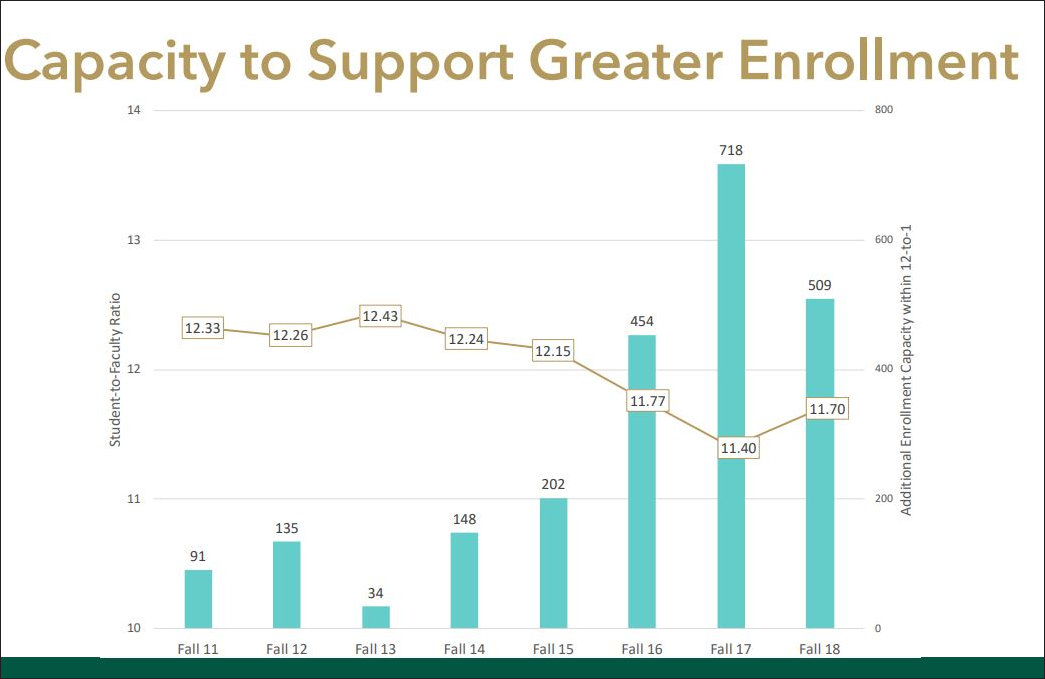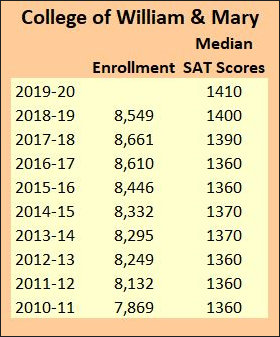
The student-faculty ratio at William & Mary (gold line) has declined in recent years, resulting in higher enrollment capacity (blue bars). Source: College of William & Mary. (Click image to enlarge.)
by James A. Bacon
Higher-ed in the United States is experiencing an enrollment crisis: A smaller generation of college-age students, a higher cost of attendance, and abundant employment opportunities have contributed to a decline in enrollment at colleges and universities for eight years running. And that worries the administration of the College of William & Mary.
In November the Board of Visitors at William & Mary addressed what the downturn might mean to the university’s high-tuition financial model. Unless new revenue sources are identified and costs contained, warned a presentation by the Ad Hoc Committee on Organizational Sustainability and Innovation, “W&M will be engaged in ongoing cost cutting to remain financially stable.”
“Unless we change our revenue stream or our cost model — that is, what we spend and how we spend it — then we would be in an ongoing cost-cutting mode for the foreseeable future to make sure that we remain in a balanced position,” Sam Jones, senior vice president for finance and administration, told the board, as reported by the Virginia Gazette. “Now that’s a significant statement for us to make but it’s really what the data has shown.”
After years of boosting tuition — W&M is the most expensive public higher-ed institution in Virginia — market constraints limit tuition “as a strategy going forward,” stated the presentation. As alternatives, W&M could consider enrollment growth or cost containment through process improvement.
The November discussion is pregnant with implications. As one of the highest-ranked public universities in the country — a commonly asked question on Google is “Is William & Mary an Ivy League school? — W&M has far more options than most institutions. Unlike private liberal arts colleges, W&M receives considerable state support and financial aid. Unlike other small public universities in Virginia, it has significant internal resources. With an endowment of roughly $1 billion, W&M is nearing completion of raising another $1 billion in its current fund-raising campaign.
As the graph atop this post shows, the university has ample leeway to increase revenue through higher enrollment. The student/faculty ratio of 11.7 to 1 is lower than the 12.3-to-1 ratio prevailing seven years ago. That implies an ability to increase enrollment by more than 500 students without exceeding the university’s teaching capacity.

After steady increases earlier in the decade, enrollment at W&M has leveled off. But the median SAT score of entering freshmen has increased. Data sources: State Council of Higher Education for Virginia
But an expansion of the student body creates a new set of hazards. The college’s admission rate was around 38%, an increase from previous years. When schools exceed a 40% acceptance rate, their perception as a highly selective, elite institution erodes, explained Tim Wolfe, associate vice president for enrollment and dean of admissions. By accepting an additional 500 students per year, W&M would likely exceed the 40% admissions revenue.
“Unfortunately, at times selectivity sometimes simply ends up being a proxy for academic reputation or quality in the eyes of prospective students and others,” Wolfe said.
Complicating the picture are gender and race ratios. This year about 59% of the accepted class was female, only 41% male. Meanwhile, like other higher-ed institutions, W&M must deal with the diversity issue. The U.S. population is increasingly dominated by “under-represented” racial/ethnic groups. Blacks and Hispanics are disproportionately likely to come from lower-income families and aren’t as academically prepared. The competition for the best African-American and Hispanic students is intense — especially for out-of-state applicants — and they are more likely to require financial assistance.
W&M is particularly sensitive to the “perception” issue after a decline in U.S. News & World-Report rankings from 38th among Best National Universities to the No. 40 spot this year. The administration attributes the drop to a change in U.S. News methodology, which placed a greater emphasis on social mobility factors.
Five years ago (in the 2013-14 academic year), W&M’s acceptance rate was an appropriately snooty 33.2%, according to State Council of Higher Education for Virginia (SCHEV) data. But by 2018-19, the university was accepting 36.9% of applicants. Then, according to the Virginia Gazette, the acceptance rate hit 38% in the current year. Though not mentioned in the article, a particularly worrisome undoubtedly was a decline in out-of-state applications over that same period — from 8,727 to 8,669 — even as out-of-state applications to public four-year Virginia institutions surged nearly 25%.
Over the same period, W&M increased tuition by more than 30% to more than $36,500 per year for tuition, fees, room and board for in-state undergraduate students. For entering out-of-state students tuition, fees, room and board is an eye-popping $60,000 (not including books, travel and incidentals). Ivy League charges without the Ivy League reputation is not a winning combination.
Although the presentation noted that “cost containment through process improvement” was a theoretical alternative for dealing with W&M’s financial and enrollment challenge, it appeared to be listed as an afterthought. The Virginia Gazette article contained no quotes to suggest that anyone explored that option during the Board of Visitors meeting.
Rather, the newspaper closed with quotes from President Katherine Rowe, who essentially defined the university’s predicament as a revenue challenge, not a cost-cutting challenge.
Ultimately, in planning for the future, William & Mary must think creatively about different streams of revenue and different ways to compete for college-aged talent, Rowe said. The fastest-growing population who wants to earn degrees in the country is adults who already have degrees and want to retrain.
“Enrollment via a four-year traditional-aged student is not going to be sufficient. We won’t be successful if we only think in those terms which is why we have groups thinking about continuing studies, thinking about adult learners, thinking about transfer students,” she said. “We don’t have one solution.”
One option not under consideration is taking a serious look at the university’s underlying cost structure. I’ll have more to say about that in another post.


